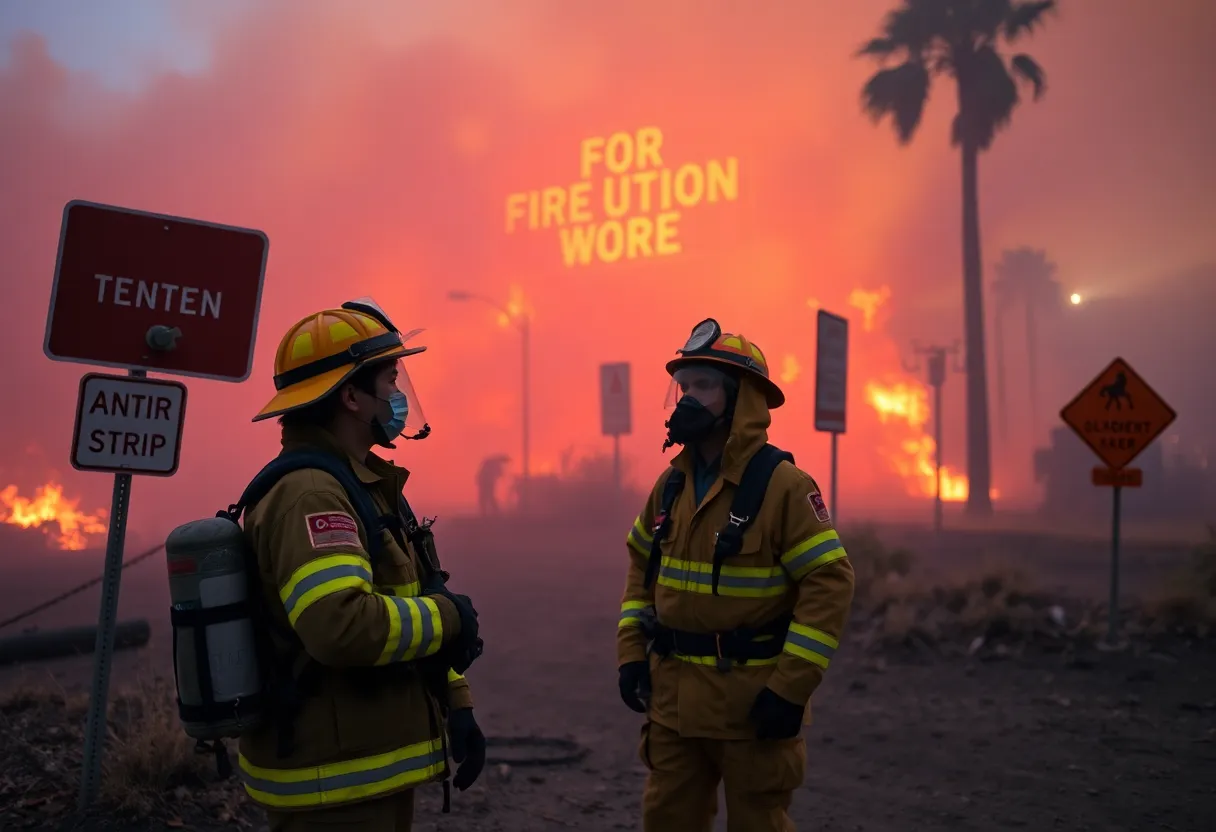News Summary
The wildfires in Los Angeles are exposing first responders to hazardous airborne toxins, including asbestos, raising serious health concerns. With the destruction of buildings, harmful particles have been released into the air, increasing the risk of mesothelioma and other diseases among emergency personnel. Authorities emphasize the need for protective measures and heightened awareness among those serving in contaminated environments, as the long-term health implications of exposure are grave.
Wildfire Aftermath Raises Alarming Risks of Mesothelioma and Other Serious Illnesses
As the catastrophic wildfires continue to engulf the Los Angeles area, a concerning reality is surfacing among local responders. Following significant damage to homes and infrastructure, authorities are increasingly aware of the dangers posed by airborne toxins. The Los Angeles County Sheriff’s Department has issued a stern warning: the possibility of exposure to asbestos and other hazardous materials in the air is palpable, necessitating immediate action from all emergency personnel.
The Hidden Dangers of Wildfire Damage
Before the 1980s, asbestos, a notorious carcinogen, was a widely utilized material in construction projects throughout the United States. With structures now burning to the ground, the microscopic particles that were once safely encased behind walls and in attics have become dislodged and entered the atmosphere. The risk of inhalation is particularly concerning for first responders on the ground, who are exposed to these toxic materials on a daily basis as they work tirelessly to protect devastated communities.
The Los Angeles County Fire Department’s hazmat team has reported that areas such as Altadena are experiencing significant air quality issues. Tests have unveiled evidence of lead, asbestos, and other harmful particulates, exacerbating the health risks for those who have been deployed to the fire zones. Authorities are adamant that extreme caution is vital, advising first responders to don N95 masks while working in contaminated environments, as well as to decontaminate their uniforms before returning home to their families.
First Responders Facing Increased Mesothelioma Risk
The warning regarding airborne toxins has evoked little surprise among the ranks of law enforcement and fire safety officials. For years, these first responders have been uniquely positioned at the forefront of hazardous situations, frequently encountering the potential for exposure to the deadly effects of malignant mesothelioma, along with other asbestos-related diseases. Symptoms among responders have been observed and reported, including severe coughing, red and itching eyes, and persistent headaches – signs of exposure to toxic agents.
Mesothelioma itself is a rare yet highly aggressive cancer directly linked to asbestos exposure, making it a central concern for first responders and their families. As firefighters, deputies, and emergency medical technicians bravely continue to put their lives on the line to safeguard the community during this crisis, they do so while carrying the burden of being aware of the long-term health consequences they may face due to their work.
Awareness and Precaution Are Key
Public safety officials are emphasizing the critical importance of awareness regarding the potential exposure risks. Firefighters and deputies remain committed to serving their community; however, they are also recognizing the imperative nature of protective measures against the dangers lurking in smoke-filled air, particularly in urban environments that may have a history of asbestos use.
The reality of working in disaster zones such as those ravaged by the recent wildfires crystallizes the need for strategic precautions in the face of potential exposure to not only asbestos but also a myriad of harmful substances linked to construction materials. While the nation has phased out the use of asbestos in contemporary construction, the haunting legacy of those bygone days continues to resonate in tragic ways.
Conclusion: Protecting Lives and Health
In the wake of these devastating wildfires, the health and safety of first responders must be a priority. As they labor selflessly, risking their own wellbeing to protect lives and properties, it is essential to remain vigilant regarding the latent hazards in their environment. The call for adequately protective measures against mesothelioma and similar illnesses cannot be understated. The vigilant actions taken by emergency personnel could very well mean the difference between life and death – not only for those they serve but for themselves as well.
In this challenging landscape, professionalism and dedication shine bright. However, understanding the risks associated with their heroism is crucial in navigating the hazardous aftermath of the wildfires.
Deeper Dive: News & Info About This Topic
HERE Resources
Middlesex County Library Undertakes Major Asbestos Removal
Asbestos Exposure and Mesothelioma: A Growing Concern for Veterans
The Forgotten Heroes: Veterans’ Battle Against Asbestos Exposure
Federal Proposal Aims to Address Asbestos Risks in Talc-Containing Cosmetics
Thalia Mara Hall’s Reopening Faces New Delays Due to Potential Asbestos Discovery
The Eaton Fire: A Community’s Resilience Amidst Tragedy
The Asbestos Dilemma: A Hidden Threat at Columbia University
Albany County Takes Bold Step with Central Warehouse Purchase
The Great Hockey Stick Heist in Duluth: Mankato West Team’s Torment
The Rising Tide of Asbestos-related Health Crises in Missouri and Beyond
Additional Resources
- Asbestos.com: Raging California Wildfires May Spread Toxic Asbestos
- Wikipedia: Asbestos
- Mesothelioma Guide: California Wildfires Asbestos Exposure
- Google Search: Asbestos Exposure Wildfires
- Asbestos.com: Asbestos Warnings Issued California Wildfires
- Google Scholar: Mesothelioma California Wildfires
- House Beautiful: Asbestos Wildfire Danger
- Encyclopedia Britannica: Mesothelioma



















